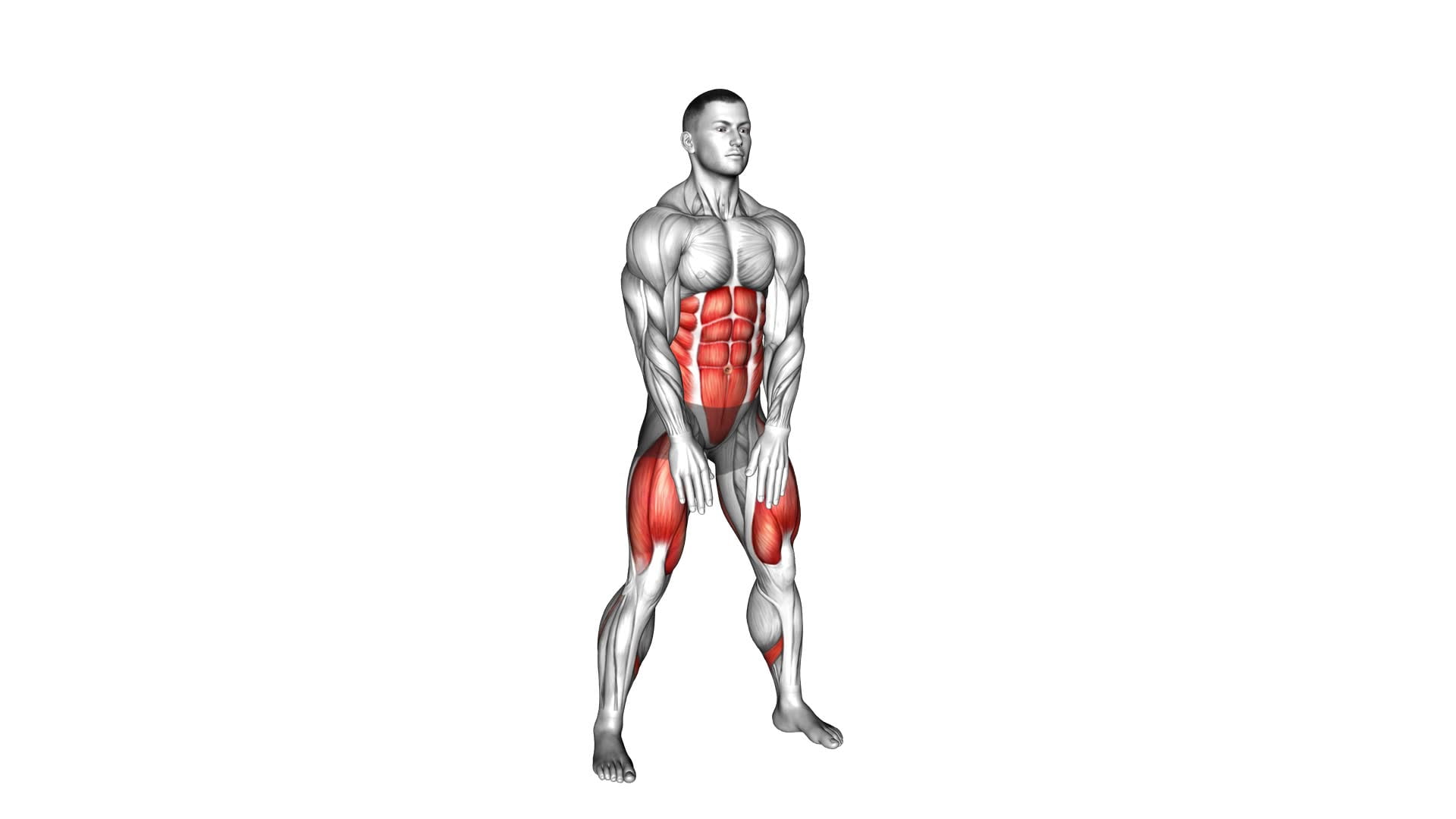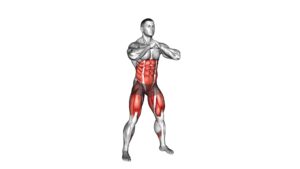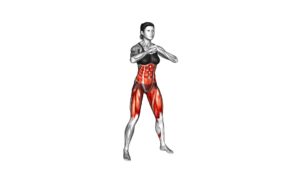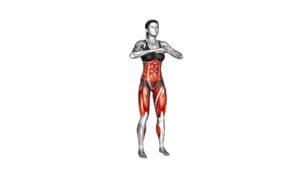High Knee Squat (VERSION 2) (male) – Video Exercise Guide & Tips

Are you ready to take your workout to the next level? Get ready to challenge your lower body strength and improve your overall fitness with the High Knee Squat (Version 2).
Watch This Exercise Video
This dynamic exercise targets your quads, glutes, and core, helping you build strength and stability.
In this video exercise guide, you'll learn the proper form and technique, variations and modifications, and tips for increasing the intensity.
Let's get started and elevate your fitness game!
Key Takeaways
- High knee squats (Version 2) improve lower body strength and stability.
- Proper form and technique are crucial for maximizing the benefits of high knee squats.
- Foot placement and hip and knee alignment are important for maintaining proper form and preventing strain or injury.
- There are variations and modifications of high knee squats that can target different muscle groups and increase the intensity of the exercise.
Benefits of the High Knee Squat (VERSION 2)
One benefit of the High Knee Squat (VERSION 2) is that it helps you improve your lower body strength and stability. By incorporating this exercise into your fitness routine, you can effectively target and activate the muscles in your legs, hips, and glutes. The High Knee Squat (VERSION 2) requires proper form and technique, which not only engages your muscles but also enhances your overall performance.
To maximize the benefits of this exercise, it's crucial to focus on proper breathing technique. As you lower yourself into the squat position, take a deep breath in. Then, as you push yourself back up, exhale forcefully. This controlled breathing pattern helps stabilize your core and maintain proper form throughout the movement.
Engaging the correct muscles is another key aspect of the High Knee Squat (VERSION 2). By consciously activating your quadriceps, hamstrings, and glutes, you can ensure that these muscles are being targeted effectively. This activation not only strengthens these muscle groups but also improves their coordination and stability.
Now that you understand the benefits of the High Knee Squat (VERSION 2), let's move on to learning the proper form and technique for this exercise.
Proper Form and Technique for the High Knee Squat (Version 2)
To perform the High Knee Squat (Version 2) with proper form and technique, it's crucial to pay attention to two key points: foot placement and hip and knee alignment.
Start by placing your feet shoulder-width apart, ensuring they're parallel to each other. This will provide a stable base for the exercise.
Additionally, keep your hips and knees aligned throughout the movement to prevent any unnecessary strain or injury.
Foot Placement Importance
Ensure proper foot placement for the High Knee Squat (Version 2) by positioning your feet in a stable and balanced stance. The way you place your feet during this exercise is crucial for maintaining proper form and maximizing the benefits. Here's why foot placement is important:
- Foot Posture: By placing your feet correctly, you can maintain proper foot posture throughout the exercise. This helps in distributing your weight evenly and prevents any unnecessary strain on your feet.
- Ankle Stability: Proper foot placement ensures good ankle stability, which is essential for maintaining balance and preventing injuries. It allows for better control and stability as you perform the High Knee Squat (Version 2).
- Balance and Control: Correct foot placement helps you maintain a stable and balanced position throughout the exercise, allowing you to focus on engaging the correct muscles and getting the most out of each repetition.
Hip and Knee Alignment
To achieve proper form and technique for the High Knee Squat (Version 2), start by aligning your hips and knees correctly. Hip flexibility and knee stability are crucial for this exercise.
Begin by standing with your feet shoulder-width apart and toes pointing slightly outward. As you lower into the squat, ensure that your knees are in line with your toes, tracking in the same direction. This alignment helps to distribute the load evenly and prevents unnecessary strain on your joints.
Keep your chest lifted, core engaged, and weight centered over your heels. Remember to maintain proper form throughout the movement, avoiding any excessive forward lean or rounding of the spine.
Variations and Modifications for the High Knee Squat (Version 2)
Try different modifications to challenge yourself and target different muscle groups during the High Knee Squat (Version 2). Don't be afraid to mix things up and push your limits.
Here are some variations and modifications you can incorporate into your High Knee Squat routine:
- Weighted High Knee Squats: Grab a pair of dumbbells or a barbell to add resistance and increase the intensity of your workout. This won't only strengthen your leg muscles but also help improve your overall endurance.
- Plyometric High Knee Squats: Incorporate explosive movements into your High Knee Squats by adding a jump at the end of each squat. This will engage your fast-twitch muscle fibers, enhancing your power and agility.
- Single-leg High Knee Squats: Challenge your balance and stability by performing the High Knee Squats on one leg at a time. This variation will activate additional stabilizer muscles and improve your overall lower body strength.
By trying these variations and modifications, you can keep your High Knee Squat routine fresh and exciting while targeting different muscle groups. Remember to always focus on maintaining proper form and gradually increase the difficulty level as you progress.
Push yourself, stay consistent, and you'll see the results you desire. Keep up the great work!
Common Mistakes to Avoid When Performing the High Knee Squat (Version 2)
When performing the High Knee Squat (Version 2), it's important to pay attention to your knee alignment and foot placement to ensure proper form and avoid common mistakes.
Keep your knees in line with your toes throughout the movement to prevent any unnecessary strain or injury.
Additionally, make sure to place your feet shoulder-width apart and keep them firmly grounded for stability and balance.
Knee Alignment Tips
One common mistake to avoid when performing the High Knee Squat (Version 2) is allowing your knees to collapse inward. Proper knee alignment is crucial for preventing knee injuries and maximizing the effectiveness of this exercise. Here are some tips to ensure proper knee alignment:
- Engage your core muscles to stabilize your body and maintain a neutral spine position.
- Keep your knees in line with your toes throughout the movement to prevent them from caving inwards.
- Focus on pushing your knees outwards as you lower into the squat position, maintaining a strong and stable base.
By practicing these knee alignment exercises and avoiding the mistake of collapsing knees, you can protect your knees from injury and optimize your performance during the High Knee Squat (Version 2).
Proper Foot Placement
To perform the High Knee Squat (Version 2) correctly, ensure proper foot placement. Proper foot placement is essential to maximize the benefits of this exercise and avoid common mistakes.
Placing your feet shoulder-width apart and parallel to each other will provide a stable base of support, allowing you to maintain balance and control throughout the movement. Avoid pointing your toes outward or inward, as this can put unnecessary strain on your knees and compromise your form.
By placing your feet correctly, you'll engage the muscles in your lower body more effectively, including your quadriceps, hamstrings, and glutes. This will help you build strength, improve your balance, and enhance your overall athletic performance.
Now that you understand the importance of proper foot placement, let's move on to some tips for increasing the intensity and difficulty of the high knee squat (Version 2).
Tips for Increasing Intensity and Difficulty of the High Knee Squat (Version 2)
Increase the challenge of the High Knee Squat (Version 2) by ramping up the speed and intensity of your movements. Push yourself to the limit and take your workout to the next level with these tips:
- Increase your speed: Move faster during each repetition, driving your knees higher and bringing them closer to your chest. This will engage your muscles more and increase the intensity of the exercise.
- Add weights: Hold dumbbells or kettlebells in your hands while performing the High Knee Squat. The added resistance will force your muscles to work harder and help you build strength and endurance.
- Try plyometric variations: Incorporate explosive movements into your High Knee Squats, such as jumping or adding a jump at the top of each squat. This won't only increase the intensity but also enhance your power and agility.
Remember to listen to your body and choose modification options that suit your fitness level. If you're just starting out, you can begin by performing the exercise at a slower pace or reducing the range of motion. As you become more comfortable, gradually increase the speed and difficulty to continue challenging yourself and achieving your fitness goals.
Keep pushing, stay focused, and you'll see amazing results!
Sample Workout Routine Incorporating the High Knee Squat (Version 2)
To incorporate the High Knee Squat (Version 2) into your workout routine, try performing a series of dynamic movements that engage multiple muscle groups. This won't only help you build strength and endurance but also enhance your overall fitness level.
Here is a sample workout routine that incorporates the High Knee Squat (Version 2) and provides modifications and tips for progress.
Begin with a dynamic warm-up, such as jogging in place or jumping jacks, to get your heart rate up and prepare your muscles for the upcoming workout.
Next, perform a set of High Knee Squats (Version 2), aiming for 10 to 12 repetitions. Remember to maintain proper form, keeping your back straight and knees aligned with your toes.
After completing the High Knee Squats, move on to other exercises that target different muscle groups. For example, you can incorporate lunges, push-ups, planks, or mountain climbers into your routine. These exercises will help you develop a well-rounded physique and improve your overall fitness.
As you progress, you can increase the intensity of your workout by adding weights, such as dumbbells or resistance bands, to the High Knee Squats or other exercises. This will challenge your muscles even more and help you continue to make progress.
Remember to listen to your body and modify the workout as needed. If an exercise feels too challenging, you can decrease the number of repetitions or modify the movement to suit your fitness level. Always prioritize proper form and technique to prevent injuries and maximize your results.
Frequently Asked Questions
How Many Calories Can Be Burned by Performing the High Knee Squat (Version 2)?
Performing the high knee squat (version 2) is a great way to burn calories and strengthen your legs. By engaging your core and raising your heart rate, you can torch those unwanted calories.
However, it's important to be cautious if you have knee injuries. Make sure to modify the exercise to suit your needs and avoid any pain or discomfort.
Can the High Knee Squat (Version 2) Be Performed by Individuals With Knee Injuries?
Yes, the high knee squat (version 2) can be modified to accommodate individuals with knee injuries. By making some adjustments, you can still benefit from this exercise while protecting your knees.
Incorporating high knee squats into your routine can actually help with knee injury rehabilitation by strengthening the surrounding muscles.
To modify the exercise, you can reduce the range of motion or use a support, like a chair, to provide stability.
Always listen to your body and consult with a medical professional if needed.
How Often Should the High Knee Squat (Version 2) Be Included in a Workout Routine?
Including the High Knee Squat (Version 2) in your workout routine can really boost your results! This exercise is a great way to work your lower body and get your heart pumping.
To properly perform the exercise, start by standing with your feet shoulder-width apart. Then, lift one knee up towards your chest while simultaneously squatting down on the other leg. Repeat on the other side.
Remember to engage your core and keep your back straight. Maximize your results by focusing on proper form and gradually increasing the intensity of the exercise.
You got this!
What Muscles Are Primarily Targeted During the High Knee Squat (Version 2)?
During the high knee squat (version 2), you primarily target your quadriceps, hamstrings, glutes, and calves. These powerhouse muscles work together to help you build strength, stability, and power.
By incorporating high knee squats into your workout routine, you can improve your lower body strength, enhance your balance, and increase your overall athletic performance.
Don't forget to try different variations of high knee squats to challenge your muscles in new ways and keep your workouts exciting!
Keep pushing yourself, and you'll see amazing results!
Are There Any Recommended Warm-Up Exercises Before Performing the High Knee Squat (Version 2)?
Before performing high knee squats (version 2), it's important to warm up your muscles to prevent injury and maximize your workout.
Recommended warm-up exercises include dynamic stretches, such as leg swings and hip circles, to increase flexibility and range of motion.
These exercises will help prepare your body for the high intensity of the high knee squat, allowing you to perform the exercise with proper form and reap the benefits of improved leg strength and cardiovascular endurance.
Conclusion
Incorporating the High Knee Squat (Version 2) into your workout routine can provide numerous benefits, including increased leg strength, improved balance, and enhanced cardiovascular endurance.
By maintaining proper form and technique, avoiding common mistakes, and incorporating variations and modifications, you can maximize the effectiveness of this exercise.
Remember to gradually increase intensity and difficulty to continue challenging your muscles.
Start adding the High Knee Squat (Version 2) to your routine today and take your fitness to the next level!

Author
Years ago, the spark of my life’s passion ignited in my mind the moment I stepped into the local gym for the first time. The inaugural bead of perspiration, the initial endeavor, the very first surge of endorphins, and a sense of pride that washed over me post-workout marked the beginning of my deep-seated interest in strength sports, fitness, and sports nutrition. This very curiosity blossomed rapidly into a profound fascination, propelling me to earn a Master’s degree in Physical Education from the Academy of Physical Education in Krakow, followed by a Sports Manager diploma from the Jagiellonian University. My journey of growth led me to gain more specialized qualifications, such as being a certified personal trainer with a focus on sports dietetics, a lifeguard, and an instructor for wellness and corrective gymnastics. Theoretical knowledge paired seamlessly with practical experience, reinforcing my belief that the transformation of individuals under my guidance was also a reflection of my personal growth. This belief holds true even today. Each day, I strive to push the boundaries and explore new realms. These realms gently elevate me to greater heights. The unique combination of passion for my field and the continuous quest for growth fuels my drive to break new ground.







